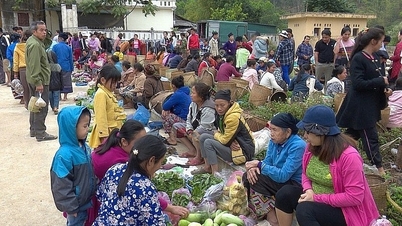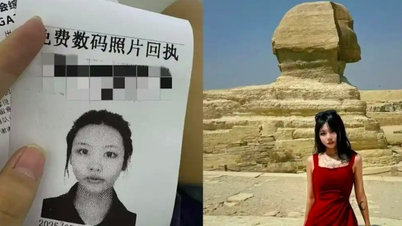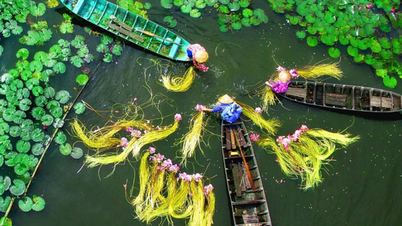About 190km from Thanh Hoa city, Bo Cung cave is located in Chanh village, Son Thuy commune, Quan Son district. Although it is one of the most remote and difficult areas in Thanh Hoa province, Quan Son district also has great potential for developing eco -tourism , community tourism... and has gradually made its mark, attracting a large number of domestic and foreign tourists in recent years.
Bo Cung Cave was accidentally discovered by a local resident in 2008 while walking in the forest. In 2009, Bo Cung Cave was ranked as a provincial-level scenic relic.
Currently, the exposed area is about 1km long, with signs, steps, and lighting installed... to serve visitors.
![[Photo] Going back to Thanh land, visiting Bo Cung cave photo 1](https://s3-hn-2.cloud.cmctelecom.vn/vietnam/resource/IMAGE/2025/1/18/5884355f03db48c9a9f62d0c5b9c4770) |
"Bo Cung" in the local Thai language means "shrimp trap". According to documents from the local culture and tourism sector, this name comes from the fact that the Xia stream flowing right in front of the cave has a lot of shrimp, which the Thai people often come to catch. |
![[Photo] Going against the Thanh land, visiting Bo Cung cave photo 2](https://s3-hn-2.cloud.cmctelecom.vn/vietnam/resource/IMAGE/2025/1/18/61a6db66c47f4272adb8bf7059e7b03d) |
Passing through the small cave entrance on the mountainside, a cool breeze will dispel fatigue, making visitors more curious and excited, stepping into the vast space with many interesting things inside. |
![[Photo] Going against the Thanh land, visiting Bo Cung cave photo 3](https://s3-hn-2.cloud.cmctelecom.vn/vietnam/resource/IMAGE/2025/1/18/aaccd15813e24784a7a4a4813be68200) |
Looking at the ceiling of the cave, visitors cannot help but be overwhelmed by the stalactites formed in a complex geological process lasting millions of years. The stalactite structures are dense and hanging down, sometimes resembling chandeliers, sometimes resembling curtains or flowers... |
![[Photo] Going against the Thanh land, visiting Bo Cung cave photo 4](https://s3-hn-2.cloud.cmctelecom.vn/vietnam/resource/IMAGE/2025/1/18/3506eb5360754f329869c4361d9f1d09) |
The stalactites and stalagmites come in a myriad of shapes and sizes, creating a vivid world that depends on each person’s imagination. With their mineral composition, many stalactites emit a magical, sparkling silver or gold light. |
![[Photo] Going back to Thanh land, visiting Bo Cung cave photo 5](https://s3-hn-2.cloud.cmctelecom.vn/vietnam/resource/IMAGE/2025/1/18/decd970fcaac4de484dedeaf8a8080dc) |
Inside the cave, there are many small niches that have not yet been fully explored. Some of the chambers are very large, up to 10 meters high, and can accommodate a large hall or stage. Standing in this deep and absolutely quiet space, one's soul seems to calm down. |
![[Photo] Going back to Thanh land, visiting Bo Cung cave photo 6](https://s3-hn-2.cloud.cmctelecom.vn/vietnam/resource/IMAGE/2025/1/18/b74ce9ac64fc4b92bc4d7a48c2dff62e) |
Chairman of Quan Son District People's Committee Le Hong Quang (third from right) led a delegation of officials from the natural resources and environment sector in Ninh Binh province to survey and visit Bo Cung cave on this occasion. |
![[Photo] Going back to Thanh land, visiting Bo Cung cave photo 7](https://s3-hn-2.cloud.cmctelecom.vn/vietnam/resource/IMAGE/2025/1/18/91685c1ddda742a88733df0567d73b98) |
At beautiful locations with spotlights, many tourists enjoy posing and capturing impressive photos. |
![[Photo] Going against the Thanh land, visiting Bo Cung cave photo 8](https://s3-hn-2.cloud.cmctelecom.vn/vietnam/resource/IMAGE/2025/1/18/4620e7f4cecd4700b562aa768266db9e) |
Rainwater and groundwater accumulate to form small lakes reflecting on stone pillars and stone screens... making the landscape in the cave even more immense and magnificent. |
![[Photo] Going back to Thanh land, visiting Bo Cung cave photo 9](https://s3-hn-2.cloud.cmctelecom.vn/vietnam/resource/IMAGE/2025/1/18/7213955eafd6410397d3c5bc5104cf6d) |
Nature also created countless "waves" of stone on the ground, among which are round stones of many sizes, like pearls. |
![[Photo] Going against the Thanh land, visiting Bo Cung cave photo 10](https://s3-hn-2.cloud.cmctelecom.vn/vietnam/resource/IMAGE/2025/1/18/63fe8ebe18f742c592e6a1ec5385636e) |
| In 2023, an expedition team from the British Royal Cave Association (BCRA) came to Bo Cung Cave to research, survey, measure, evaluate and announce that Bo Cung Cave was formed about 4 million years ago, 420m above sea level, and is a cave with many rare stalactites and stalagmites in the world. Bo Cung Cave is not only of great value for scientific research but also has great potential for developing cave tourism. |
![[Photo] Going back to Thanh land, visiting Bo Cung cave photo 11](https://s3-hn-2.cloud.cmctelecom.vn/vietnam/resource/IMAGE/2025/1/18/bbca1259e35243c491f887e6900b530f) |
Thanks to the fairly flat and properly lit paths, Bo Cung Cave is a friendly destination for almost all visitors, including the elderly and children, who can easily go deep to explore and experience. |
![[Photo] Going back to Thanh land, visiting Bo Cung cave photo 12](https://s3-hn-2.cloud.cmctelecom.vn/vietnam/resource/IMAGE/2025/1/18/1f7a2a6c0bf048468c911859986bcb5c) |
Before or after the visit to Bo Cung cave, visitors can spend time playing, relaxing, and enjoying local cuisine along the cool Xia stream nearby. |
Continuing the journey to visit Quan Son district, there are many pristine and interesting tourist routes and destinations, such as: visiting Ban Nhai waterfall and learning about the brocade weaving craft of Ban Ngam (Son Dien commune), community tourism to experience Thai culture in Tong village (Trung Tien commune), bathing in the hot spring of Ban Khan (Trung Thuong commune), visiting the temple of General Tu Ma Hai Dao (Son Thuy commune), ... and especially connecting with tourism in Hua Phan province (Laos) through Na Meo international border gate.
Source: https://nhandan.vn/anh-nguoc-ngan-xu-thanh-tham-dong-bo-cung-post815092.html




![[Photo] Keep your warehouse safe in all situations](https://vphoto.vietnam.vn/thumb/1200x675/vietnam/resource/IMAGE/2025/10/1/3eb4eceafe68497989865e7faa4e4d0e)
![[Photo] Hanoi morning of October 1: Prolonged flooding, people wade to work](https://vphoto.vietnam.vn/thumb/1200x675/vietnam/resource/IMAGE/2025/10/1/189be28938e3493fa26b2938efa2059e)
![[Photo] President of the Cuban National Assembly visits President Ho Chi Minh's Mausoleum](https://vphoto.vietnam.vn/thumb/1200x675/vietnam/resource/IMAGE/2025/10/1/39f1142310fc4dae9e3de4fcc9ac2ed0)
























































































Comment (0)